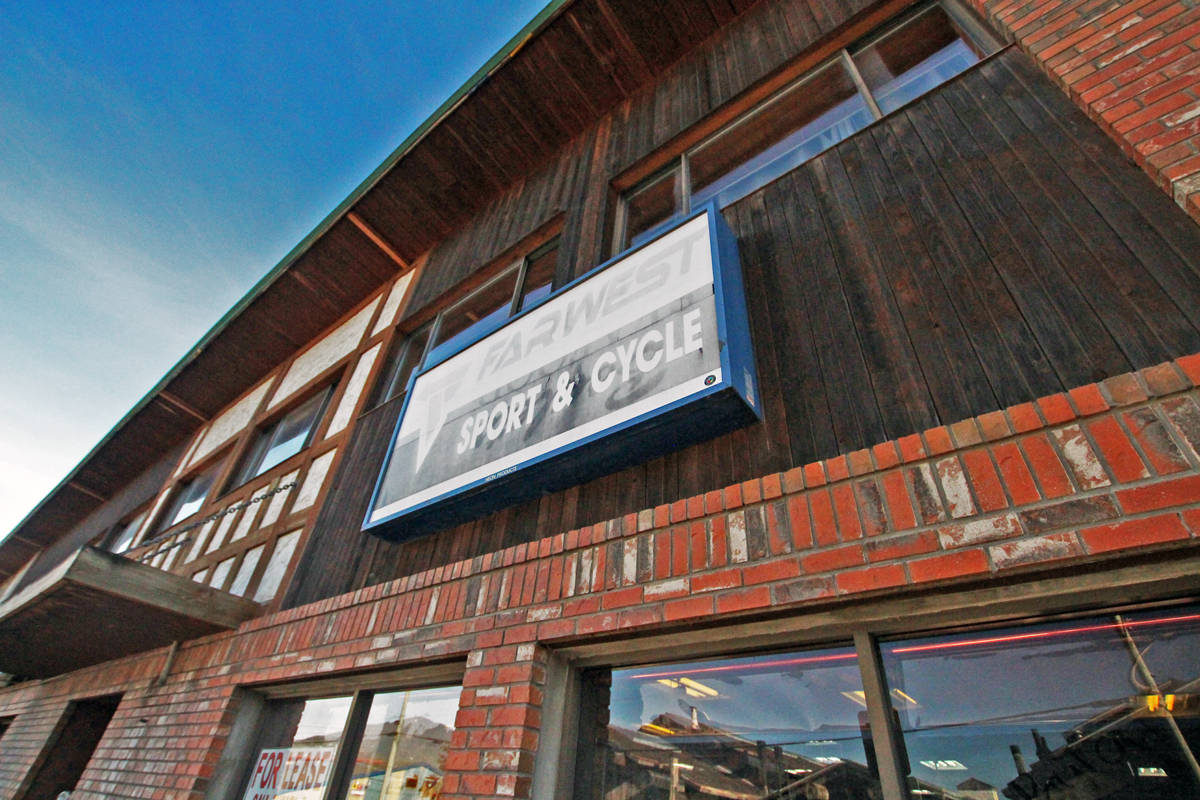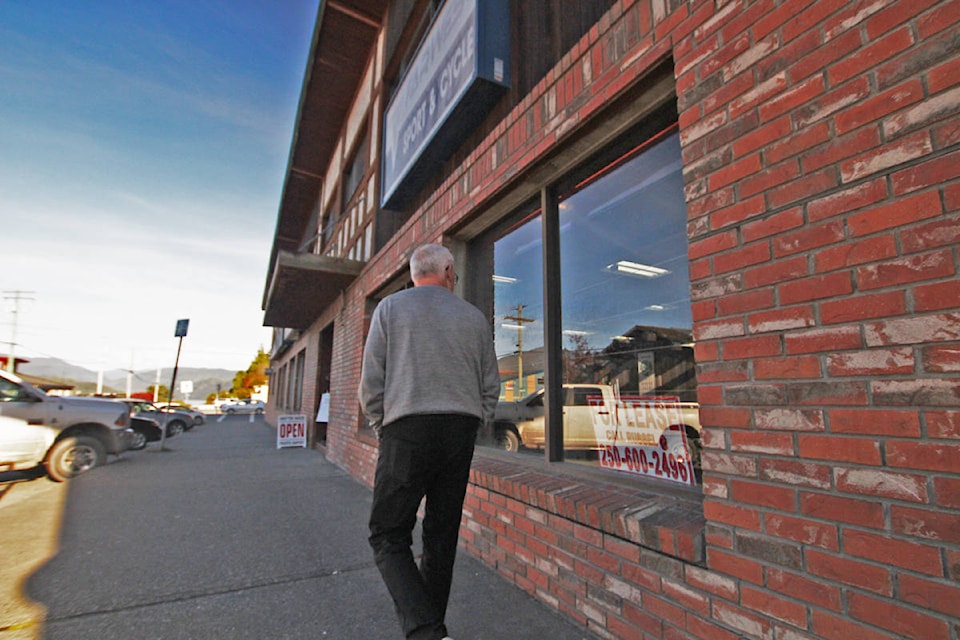Few have witnessed the transformation of the retail landscape in Prince Rupert like Iain Cullen, who owned and operated Far West Sports from the pre-internet days of 1972 to the smartphone and iPad era of 2016.
Cullen said that the business climate in which retailers had to operate changed dramatically. In the pre-internet era, a local brick and mortar store was the most convenient place to shop. Now, consumers, especially younger ones, have nearly unlimited options that can be accessed at the swipe of a finger.
“The teenager is now online,” he said. “That’s what they want to do.”
The ease, convenience and relatively low cost for consumers to continually go online, meant they would swallow shipping costs at the expense of locally owned and operated businesses, who had a hard time competing.
“It just puts an added burden and time pressure on business owners to be really flexible to the local market,” said Blair Mirau, a councillor for the City of Prince Rupert, as well as the chair of the small business advisory committee.
Issues with supply
Cullen, who witnessed the transition to online over his 25 years in business, also said, not only did the consumer change, but the attitudes of his suppliers changed.
“Sometimes, if I didn’t have a product in store, the wholesaler would tell me to tell the customer to go online,” he said. “If I did that, I don’t make a dime and I’m not serving my customer.”
Cullen said business at Far West slowed down as a result of the changes, but it remained viable because it was an established entity with a reputation for excellent customer service. He had relationships with suppliers that smoothed the process of ordering inventory.
For those attempting to break into the retail sector in the Amazon era, building a business and brand from scratch would be much more challenging both from the consumer and supplier side.
For example, the most popular sports brands (Nike, Under Armour and Adidas) all require minimum purchase orders of anywhere between $15,000-$50,000 to supply to a store. A fledgling store trying to build its business may have a harder time moving that much product off its shelves. Before closing her retail shop, Oceanside Sports, Sheri Pringle said she struggled in this department.
“There are some companies I have contacted repeatedly to say that I’d like to open a contract, and they have no interest in doing that,” Pringle said. “You have to have a big minimum to stay with them, and you have to pay up front and then you can’t send it back.”
A shortage in labour
Adding further complication to the issue is the fact that it is hard for retailers to find consistent dependable labour, a result of considerably more lucrative options elsewhere in Prince Rupert.
In a survey of 75 Prince Rupert businesses conducted in May 2018, 60 per cent identified availability of staff as their biggest challenge, which was a 56 per cent increase in that category from the previous survey in 2016.
“DP World and longshoring pays well and that’s become a viable option for people, and it’s harder now to get those employees at that lower rung,” said John Farrell. “It’s an added expense and it’s added anxiety because even though you have the drive to build your business, it’s now a cap on how much you can drive your business because you’re not assured that you’re going to have consistent employees.”
Farrell added there are business owners who work for the port while operating their business, which eventually becomes too overwhelming. Some have decided that it is too much to balance both.
“We do have business people saying, ‘It’s too much, it’s hard finding employees, I’m not seeing as much uptake in terms of customers and I think it’s just easier for me to go and pick another career that pays well,” he said.
READ MORE: Rupert small business recruitment suffering
Taxes
Business owners in Prince Rupert have also paid consistently higher property taxes than most other municipalities in Northern B.C over the past 13 years.
In 2005, Prince Rupert businesses paid 34.7 per cent in taxes, according to the province’s financial statistics records. This number was higher than in Terrace (26.3 per cent), Smithers (21.2 per cent), Vanderhoof (16 per cent), Prince George (18 per cent), Quesnel (12.2 per cent), Williams Lake (12 per cent), Kitimat (13.1 per cent) or Telkwa (12.3 per cent).
After peaking in 2006 at 36.5 per cent, those number declined steadily between 2007 and 2018. This year, the business tax rate stands at 25.2 per cent, a significantly lower number than the mid 2000s. However, 25 per cent is still a significant burden, and one that is higher for Prince Rupert busineses than their northern counterparts in other cities.
In 2017, Rupert businesses had a 25.7 per cent tax rate, a higher figure than Terrace (21.2 per cent), Prince George (17.5 per cent), Kitimat (14.1 per cent), Quesnel (14.3 per cent), Vanderhoof (13.9 per cent), Williams Lake (13 per cent) and Telkwa (11.9 per cent).
The reasons for this are numerous and complex, but the end result is that small business owners in Prince Rupert are operating in an environment where they are squeezed from both sides. A shrinking customer base combined with ever increasing operating costs have resulted in both smaller margins and a smaller margin for error.
Many factors
All of these factors combine to create an environment where owning a retail store in Prince Rupert is not impossible, but the barriers to entry can make it unappealing when there are more lucrative alternatives available.
In Pringle’s case, Oceanside Sports was still profitable when she made the decision to close, it just wasn’t profitable enough after nearly nine years in business for her to want to continue. She admits that she would have had a hard time surviving if she didn’t take on extra jobs for supplementary income, and in the end, it just wasn’t worth it.
“Do you keep spinning your wheels at something when you’ve got other jobs and there are other opportunities that have come along,” said Pringle. “I have great staff, I have great, loyal customers, but I can’t have my hands into everything.”
The decline of retail in Prince Rupert has seen a growing number of empty buildings. As of October, there are dozens of empty buildings in the city, many of which have been empty for more than 10 years and are asking for up to half a million dollars to purchase. Derelict and in disrepair, the city has struggled to enforce its own bylaws to maintain the buildings.
Hope for the future?
With online competition, difficulty finding employees, high taxes and rents, a growing number of empty buildings, where exactly does the city go from here?
Work has been done to find solutions to the existing problems with an eye on creating an environment where retail business can thrive. Research began in 2016 with the Redesign Rupert campaign, and with the mayor’s acclamation, the program is set to continue for the next four years.
Also, for all of the retail businesses that have folded under the weight of Prince Rupert’s economic downturn, there are examples of retail stores that were not only able to survive, but thrive. Not only are they still standing, but their owners would argue that they have become stronger due to adversity.
What were the keys to their success, what lessons can be learned, what has the city found through Redesign Rupert research, and how will those results help determine the next steps to revitalize its retail sector?
Part 1: Death of Retail in Prince Rupert
Part III next week - What are we doing about it?
matthew.allen@thenorthernview.com
Like us on Facebook and follow us on Twitter

